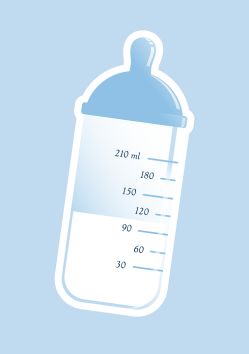Why it is advisable to Buy Anti Colic Baby Bottles?

Babies sometimes turn fussy and cry for a prolonged period of time, leaving parents confused and about what is bothering their little ones. These bouts, termed colic, can be worrisome, especially for first-time parents. While there is no conclusive evidence as to what causes colic in babies, many point to the gas that builds in their stomach during feeding. Air makes its way into the baby’s tummy while he drinks milk and can cause uneasiness inside till burped out. Feeding bottles also can sometimes be culprits in colic. This is especially true with formula milk that is prepared or mixed within the bottle itself.
Why you need anti-colic bottles
Regular bottles tend to pass on tiny bubbles of air into your baby’s tummy as he feeds from it. This could be from the vacuum that builds up inside the bottle or the froth that gets produced when you shake the formula vigorously inside the bottle during preparation. Either way, your little one ends up gassy and more colic-prone. Anti colic bottles contain special features that prevent the excess air from getting passed on.
How anti colic bottles work
The anti colic features in a baby bottle can be incorporated in different ways. Here is a look at three common ones.
● Air vents in the nipple, teat, or bottle
Bottles with air vents are the most common kind in anti colic feeding bottles. Specially placed holes in the nipples or teats help the air the builds to vent into the bottle so that the milk being sucked out is replaced smoothly without a vacuum build-up. This way, the milk doesn’t get frothy or aerated as the little bubbles of air vent back up the side of the bottle. Some bottles are also designed with bottom air vents, which remove the air from the teat and make feeding smoother.
● Straws or tubing
Some other kinds of feeding bottles incorporate anti colic features via a straw or tubing system. In this, a tube runs from the back of the teat all the way to the base of the bottle. This design allows air to flow through the straw without causing a vacuum build up inside the bottle. This aids in a smooth, even flow of milk through the teat, and prevents your little one from swallowing air bubbles. However, sterilization of such bottles may be a tad more difficult considering the added number of parts and tiny tubes that require thorough cleaning.
● Suction system
The best bottles for colic available in the market function using suction systems. This may be a disposable liner that collapses as the baby drinks the milk inside. Or it may be a base designed to move up as the quantity of milk within the bottle reduces with feeding. As the space within the bottle gets smaller, there is little or no vacuum that is created. Thus allowing your tiny tot to take up milk and no air bubbles.
Choosing the best anti colic bottle
● Anti colic feeding bottles are typically made of plastic. However, when choosing them, remember to pick bottles that are made of baby-safe materials, and which are free of BPA< phthalates, and PVC.
● Opt for a bottle size that suits your baby’s feeding needs. Remember to stock a larger number of bottles if your little one is exclusively formula fed or if you pump and store breast milk for later use by your baby.
● Choose a nipple that fits your baby suckling needs. Your tiny tot will be most comfortable sucking out of an artificial nipple that gives a breastfeeding-like feel. This is especially important if you are weaning your child off breastmilk and slowly introducing a bottle. Also, pay attention to the nipple size. It must fit the mouth of your baby comfortable while allowing milk to flow freely through the opening. Neither should it leave your baby sucking hard for milk (this can cause him to suck in more air in the process), nor should it fill his mouth with excessive milk, causing him to choke.
● Choose anti colic bottles with mixers. Baby formula blenders can mix formula and baby cereals seamlessly while also reducing frothing by a great deal. This makes the anti colic bottle a lot more effective as less air makes its way into your baby’s food, and consequently, his tummy.
